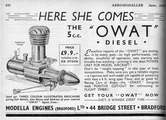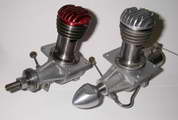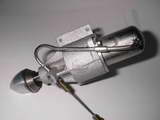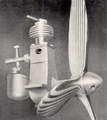The Owat 5cc Diesel
by Adrian Duncan
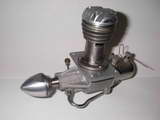 |
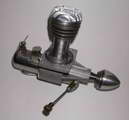 |
|
| Click on images to view larger picture. | ||
The Owat 5 cc fixed-compression diesel (incorrectly spelled Owatt by the late OFW Fisher in his well-known model engine book) was a short-lived British-made fixed-compression diesel made shortly after World War II in Bradford, Yorkshire. It has often been mistaken for the very similar Micron 5cc fixed-comp engine, of which it was doubtless a rather unashamed copy. In large part, this write-up is intended to set the differences in perspective in addition to pointing out the similarities. Vive la difference!
The manufacture of the Owat was confined to the period 1946 through 1947. At the time of publication of DJ Laidlaw-Dickson's 1946 book, "Model Diesels", it was just coming onto the market and was included in the table of British diesels scheduled for full-scale production in 1947. "ARTIFEX" (LH Sparey), writing on British Diesel engines in the Aeromodeller of May 1947 observes: The long awaited Owat has finally overcome its production difficulties to emerge in a shape almost identical with the French Micron 5cc." (p361).
It was mentioned again in the first edition of Col. CE Bowden's 1947 book, "Diesel Model Engines". The first advertisement appeared in the June 1947 issue of the Aeromodeller priced at £9 9s. The engine only made one more appearance in Aeromodeller and production of the engine does not appear to have continued beyond 1947. Consequently, the engine is pretty rare today, particularly in as pristine condition as the illustrated example from my own collection, although examples do still turn up from time to time.
The manufacturers of the Owat were Modella Engines (Bradford) Ltd of 44 Bridge Street, Bradford, Yorkshire, just west of Leeds. The origin of the name "Owat" is undeniably rather obscure, bearing no evident relationship to the company name. No doubt there would be a story there if anyone were still around to tell it after the passage of 62 years! Perhaps one of the designers was a passionate follower of Yorkshire's sporting passion, cricket?!? "Owzzat?!?"
The engines were distributed by Richard Rogard Ltd. of 2 Carlisle Road, Bradford, so this was an all-Yorkshire effort! They were advertised, although I'm not clear to what extent or in which publication(s). The advertisement here appeared on the inside front cover of the first edition of Col. Bowden's 1947 book mentioned earlier, along with similar ads for the ETA "5", the Mills 1.3, the ED Mk. II and the Amco .87.
The Owat ad includes some rather impressive claims for the standard engine's performance, a speed of 68 mph in a model car being quoted. The ad also confirms that there was another "super" version which was fitted with a clutch and flywheel and which was claimed to produce even higher performance. The presence of a clutch implies pretty clearly that this version was intended primarily for model car use.
The price of the standard model was given as 6 guineas (�6 6s 0d), which was a pretty steep price in immediate post WWII Britain, although one third less than the price advertised in Aeromodeller of 1947. And that was just the basic model—one had to pay an extra �2 18s 0d for the "super" version with clutch and flywheel. It would appear from the content of this advertisement that the Owat was aimed as much at the then-thriving model car market as that for model aero engines.
In his 1946 book, Laidlaw-Dickson gave the nominal bore and stroke of the Owat as 17mm x 21.75mm respectively. Mine measures up at 16.99mm x 21.82mm for a displacement of 4.95 cc—near enough, allowing for "lathe operator's license"! The comparable nominal measurements for the Micron are 17.00mm x 22.00mm for a capacity of 4.99 cc—again, near enough as makes no difference. The table included in Laidlaw-Dickson's book gives a weight of 11 ounces for the Owat—a little on the low side by my own measurements, which yield a weight of 11.625 ounces with tank for the illustrated example. Laidlaw-Dickson gives the rpm as 5,000, and states that a 14 x 9 prop was recommended for aircraft use.
The manufacturer's recommended fuel as reported by Laidlaw-Dickson was interesting—70% ether, 10% lubricating oil (Castrol XXL—a mineral oil—was the usual type used in Britain at the time) and 20% "pool" petrol (i.e., rot-gut grade gasoline!). EEEK! Pretty thin on the oil content, and detonation must have been fierce!
Mind you, the issue of the "best" diesel fuel was still a matter upon which there was little agreement at this time. Col. Bowden had his own "recommended" mixture, which he claimed to be suitable for diesel engines of all types, fixed compression or otherwise. The gallant Colonel had the bottle to run his fixed-compression engines (and others) on a fuel consisting of 50% ether, 40% road diesel oil and a mere 10% Castrol XXL! In his book, he admits to having had to alter the compression ratios of his fixed-compers to accommodate this fuel—hardly surprising, since it would be bound to run pretty hot with that proportion of high-calorie diesel oil! He also recommended against the use of petrol as a constituent of model diesel fuels—wise man!
Apart from the advertisement noted earlier, the Owat also featured in the main text of Col. Bowden's 1947 first edition, although it was not mentioned even retrospectively in the Colonel's 1951 third edition (which is the version reproduced in the "modern" facsimile edition published by TEE Publishing—it differs quite substantially from the first edition). On page 49 of the first edition Bowden notes the Owat's similarity to the Micron 5 cc model and mentions the fact that at the time of writing he had an Owat installed in a large low-wing monoplane. Most intriguingly, he also mentions his understanding that the manufacture of the Owat had then (in 1947) recently passed to another firm, but is not specific on this point. He gives the weight of the engine as 12 ounces.
As I said at the outset, the Owat has often been confused with the 5 cc Micron. Looking at the two engines side by side, this is quite understandable! I actually obtained my own pristine example many years ago as a "Micron", thinking that it was a different variant from the one that I already had—it was only after examining it and comparing it with my existing Micron that I realized what it was! The British threads used throughout were a dead giveaway for starters. Another giveaway is the fact that the Owat has a serial number—in this case, B29 stamped on the upper surface of the right mounting lug. The Micron does not have such a number.
I believe that not all Microns had the red anodized head, so that may not be a definitive means of identification. The Owat is slightly bulkier overall and has a more roughly-cast crankcase—in fact, the external finish overall is a little rougher. But the Owat is every bit the equal of the Micron where it counts—the mechanical workmanship and standard of fitting of both motors are up to the very highest model engineering standards throughout.
Material spec is pretty standard—steel cylinder, cast iron piston, nickel-chrome steel shaft and alloy rod. In the latter regard, it's my opinion that the Owat is superior to the Micron, which uses a steel stamping for its rod. I've never really liked steel rods—they tend to chew up crankpins and gudgeon pins, particularly when used in diesels. In my view, alloy is far superior, or steel with a bronze bushing A fully floating steel gudgeon pin with brass end caps is employed. Like the Micron, the piston top has a cut-away on the transfer side just like that used on the Mills and ED sideport engines to direct the incoming charge.
The bulkier construction of the Owat is reflected in its weight—as noted previously, the thing weighs 11.625 ounces complete with tank, which compares with 10.75 ounces for the Micron with tank. Removal of the Owat tank would doubtless get the weight down below 11 ounces, but the beast is undeniably heavy.
The tank on the Micron (not in place in the photo) is identical to that of the Owat, but is made of un-plated brass, while that of the Owat is plated. Note the fact that the fuel line on the Owat is also of plated metal and is soldered at both ends to the tank and spraybar respectively! This means that, as supplied, you have to use the tank supplied with the Owat to run it. And that in turn dictates an upright mounting position since the tank only works in that position, and the fact that it is hard-wired to the spraybar means that, unlike that of the Micron, it cannot be remounted at 180 degrees for inverted running unless the fuel line is completely re-configured. The Micron uses plastic fuel tubing between the tank and the spraybar, which means that the tank can be used in both upright and inverted positions. Alternatively, a completely different tank may readily be employed with the Micron.
If you want to use an alternative tank with the Owat (which you pretty much have to do if you want to mount it in any orientation other than upright), then a different needle valve assembly must be installed or the metal fuel line cut to allow the use of a different tank. Interestingly, the manufacturers clearly anticipated this problem—note the metal sleeve visible in the underside view which appears part-way along the fuel line on the Owat! This is soft-soldered in place, and this step was presumably taken only after the tank and spraybar were both in place. But naturally the sleeve could just as easily be unsoldered! I'm sure that this was the maker's intent—if the engine was to be used without the supplied back tank, then the line could be separated from the tank simply by unsoldering this sleeve. The connection could of course be easily re-established at any time if desired. A nice touch...
There are a few other differences between the Owat and the Micron—the needles are a little different, for one thing. The Owat uses a conventional British-style split thimble arrangement which screws onto the externally-threaded spraybar in the familiar manner. The Micron uses a threaded needle screwing into an internally-threaded spraybar. The split thimble on the Micron is unthreaded and is a tight fit over the unthreaded outer surface of the spraybar. It is tensioned against the spraybar by a wrap-around coil spring—neat and effective, albeit more complex than the Owat set-up. The Micron also features a very handy 90 degree fuel line attachment spigot located on the same side of the spraybar as the needle.
Another give-away difference is the fact that the metal tank of the Micron uses a screw-in fuel tank filler cap, while the Owat sports a made-in-England No. 3 Partridge Flip-Flap unit. Finally, the method of mounting the prop driver is different—both drivers are of steel, but the Micron unit is a simple relatively thin disc which keys onto a square-cut section of the shaft just in front of the main bearing, while the thicker Owat unit is internally and externally tapered from the rear and fits onto a matching taper machined into the front of the shaft at the point where the diameter is reduced in front of the main bearing. The Owat system appears to be the more dependable—no stress-raiser in the shaft. The knurling on the gripping face of the driver is far coarser and probably more effective on the Owat than it is on the Micron.
On page 28 of his book, Fisher states that most of the Owat engines had red-painted cases. I can only comment that mine shows no evidence of ever having been painted at all. It has never been mounted in a model, and I would judge it to be almost unused. So I doubt that the paint has worn off or been removed. But it must be said that the example illustrated on page 47 of Col. Bowden's book appears to have a painted case. So I'd say that Fisher may well have been correct in making this statement.
Regardless, it should now be clear that there are plenty of clues through which the Micron and Owat engines may readily be distinguished from one another. But there's no getting away from the fact that the Owat is basically a close copy of the then highly regarded Micron. One direct similarity is the fuel cut-off used on both engines. This is of the spring-loaded plunger type, with a wire arm that snaps into a groove around the plunger body to keep it open for running. When the arm is pulled backwards by whatever timer is used, the plunger snaps shut and cuts off the fuel supply at the tank. The engine takes a few seconds to stop using this system, but it's far better than nothing! The two attached rear views show this cut-off in both running and stopped positions. Col. Bowden criticized this type of device on page 120 of his 1947 first edition on the grounds that there were few timing devices with the power to operate it! It is undeniably true that it takes a pretty good tug on the arm to release the plunger.
The upper surfaces of the mounting lugs on both the Owat and the Micron are machined flat, while the lower surfaces are left as cast, complete with draft. So the bearers have to be located on top of the lugs (with an upright mount in the case of the Owat if the supplied tank is to be used). Incidentally, the mounts of the two engines are interchangeable—the Owat's lugs are slightly wider and longer overall, but the hole spacing is identical. This cannot be coincidental—clearly Modella Engines were hoping to entice some Micron users to make the switch! And they seem to have succeeded—Col. Bowden actually mentions in his 1947 book (pages 49-50) that he was accustomed to switching back and forth between his Owat and Micron 5 cc engines in the low-wing monoplane which he had built for these two engines.
I've actually run both my Owat and my Micron, using suitable protection for the lugs to keep them from being marred. For convenience of mounting and protection of the cases I ran them inverted in the test stand, which forced me to use a different needle valve in the Owat. But I was able to try the timer by using the Micron tank since this can be connected with fuel tubing. I couldn't work up the bottle to try the Owat mix—I used my usual fixed-comp mix of 75% ether and 25% SAE 30 mineral oil, which worked perfectly. The two engines both start and run extremely well, as long as you follow the correct procedures given that these are fixed-compression engines. The smoothness of running is very impressive indeed. The Owat seems to have a performance that is quite comparable to that of the Micron, although I've never actually run any exhaustive comparative tests. Neither are as powerful as the American Drone, though. Not having a 14x9 prop handy, I used a 13 x 6, which both engines turned very steadily at around 6000 rpm. This makes the claim of 5,000 rpm on a 14 x 9 appear quite credible to me—my example is still quite stiff. The Drone manages around 6,800 rpm on the same 13 x 6 prop.
I always think that connections are very important when writing about any form of history, even something as prosaic as model aero engines! Accordingly, as a footnote to the Owat story it seems worth mentioning that model engine manufacture appears to have been something of a preoccupation in post-war Bradford! Apart from our friends Modella Engines producing the Owat at 44 Bridge Street in Bradford, there was also Leesil Ltd of 1 Arthington Street, Bradford! Two model engine manufacturers in one small Yorkshire town at the same time during the early years of the post-war development of the model diesel engine! One suspects a connection or at least a cross-town rivalry of some kind. It actually seems possible that the manufacture of the two models was combined at some point in the hands of one or other of the two firms, hence giving rise to Col. Bowden's comment noted earlier regarding a change of manufacturer for the Owat in 1947. However, there's no way of establishing this one way or another unless someone as knows summat steps oop to 't wicket...
The Leesil 24 was a 2.4 cc sideport diesel engine of rather pleasing proportions which entered production in 1946 at roughly the same time as the Owat from just up the road. Bore and stroke were 12.7mm x 18.0mm respectively. Being in a different capacity class, it was not of course in direct competition with the Owat. In some ways it was a more advanced design, featuring variable compression as opposed to the fixed compression of the Owat. It seems to have been influenced more by the Swiss Dyno than anything else—Col. Bowden states as much quite directly (page 48). The picture here is from page 30 of Laidlaw-Dickson's 1946 mentioned ealier.
The early versions of the Leesil had a sand-cast case. This version apparently experienced some problems, and the design was revised later in 1946 to include a die-cast crankcase among other refinements. This doesn't seem to have helped matters greatly, since the engine did not survive in the marketplace, being phased out in 1947 along with its home-town rival, the Owat. Its weight of a full 7 ounces (for a 2.4 cc engine!) probably had something to do with this. Bradford's reign as a Northern centre of model engine manufacture was thus very short!
Anyway, there it is—another British lump with an interesting story to tell. Only wish we could tell more of it!
This page designed to look best when using anything but IE!
Please submit all questions and comments to
[email protected]
|
Unless otherwise expressed, all original text, drawings, and photographs created by
Ronald A Chernich appearing on the Model Engine News web site are licensed under a Creative Commons Attribution-Noncommercial-Share Alike 3.0 License. |

|
